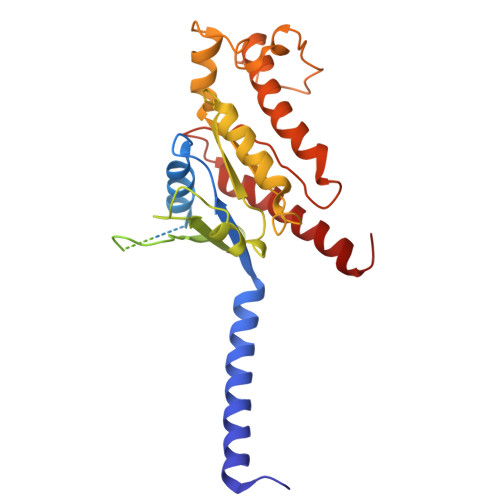Sensing ceramides by CYSLTR2 and P2RY6 to aggravate atherosclerosis.
Zhang, S., Lin, H., Wang, J., Rui, J., Wang, T., Cai, Z., Huang, S., Gao, Y., Ma, T., Fan, R., Dai, R., Li, Z., Jia, Y., Chen, Q., He, H., Tan, J., Zhu, S., Gu, R., Dong, Z., Li, M., Xie, E., Fu, Y., Zheng, J., Jiang, C., Sun, J., Kong, W.(2025) Nature 641: 476-485
- PubMed: 40049228
- DOI: https://doi.org/10.1038/s41586-025-08792-8
- Primary Citation of Related Structures:
9JH5, 9JH6 - PubMed Abstract:
Recent evidence has shown that increased levels of circulating long-chain ceramides predict atherosclerotic cardiovascular disease independently of cholesterol 1,2 . Although targeting ceramide signalling may provide therapeutic benefits beyond the treatment of hypercholesterolaemia, the underlying mechanism by which circulating ceramides aggravate atherosclerotic cardiovascular disease remains elusive. Here we examine whether circulating long-chain ceramides activate membrane G-protein-coupled receptors to exacerbate atherosclerosis. We perform a systematic screen that combines G-protein-signalling quantification, bioinformatic analysis of G-protein-coupled receptor expression and functional examination of NLRP3 inflammasome activation. The results suggest that CYSLTR2 and P2RY6 are potential endogenous receptors of C16:0 ceramide-induced inflammasome activation in both endothelial cells and macrophages. Inhibition of CYSLTR2 and P2RY6 genetically or pharmacologically alleviates ceramide-induced atherosclerosis aggravation. Moreover, increased ceramide levels correlate with the severity of coronary artery disease in patients with varying degrees of renal impairment. Notably, CYSLTR2 and P2RY6 deficiency mitigates chronic-kidney-disease-aggravated atherosclerosis in mice without affecting cholesterol or ceramide levels. Structural analyses of ceramide-CYSLTR2-G q complexes reveal that both C16:0 and C20:0 ceramides bind in an inclined channel-like ligand-binding pocket on CYSLTR2. We further reveal an unconventional mechanism underlying ceramide-induced CYSLTR2 activation and the CYSLTR2-G q interface. Overall, our study provides structural and molecular mechanisms of how long-chain ceramides initiate transmembrane G q and inflammasome signalling through direct binding to CYSLTR2 and P2RY6 receptors. Therefore, blocking these signals may provide a new therapeutic potential to treat atherosclerosis-related diseases.
- Department of Physiology and Pathophysiology, School of Basic Medical Sciences, Peking University Health Science Center, Beijing, P. R. China.
Organizational Affiliation:






















